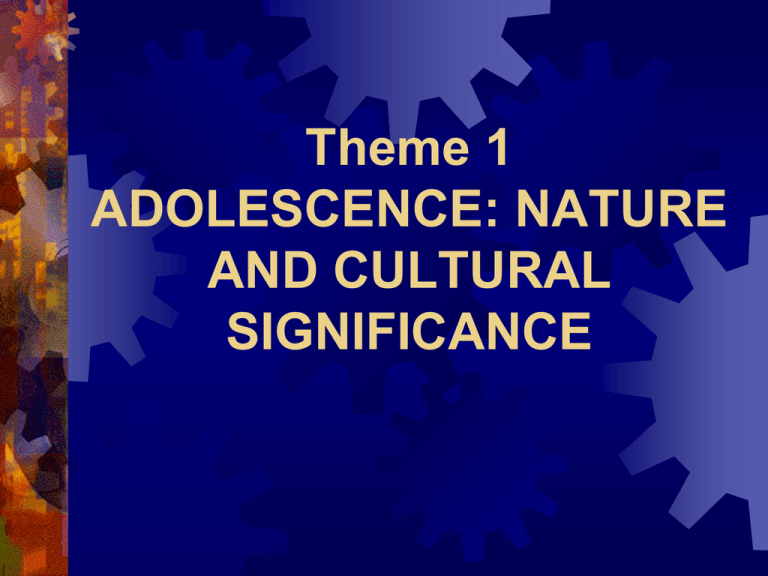
Theme 1
ADOLESCENCE: NATURE
AND CULTURAL
SIGNIFICANCE
INDEX
Adolescence and culture
Theories about adolescence: Hall, Freud,
Blos, Havighurst, Mead, Benedict, Coleman
Physical changes and their psychological
consequences
Adolescence in XXIth century
¿Is adolescence an universal and natural
process or, instead, is a cultural
construction?
Adolescence in Western countries
Rites of passage
Puberty and adolescence
Adolescence
TOPICS
A time of storm & stress
A time of family and social conflict
“I
would there were no age between ten and three-andtwenty, or that youth would sleep out the
rest; for there is nothing in the between but getting
wenches with child, wronging the ancientry, stealing,
fighting...”
Shakespeare (A Winter’s Tale)
La juventud actual ama el lujo, es maliciosa, es
malcriada, se burla de la autoridad y no tiene ningún
respeto por los mayores. Nuestros muchachos de hoy
son unos tiranos, que no se levantan cuando un
anciano entra a alguna parte, que responden con
altanería a sus padres y se complacen en ser gentes
de mala fe..."
a) Angel Acebes
c) Federico Jiménez Losantos
b) Juan Pablo II
d) Sócrates
SOCRATES, SIGLO IV A.C
¿What is adolescence?
A time of Storm and stress
¿?
A normal developmental
stage
Adolescence
The reality
It is not necessarily a conflict or break time
A period of important changes (physical,
cognitive, emotional, social)
Problems in 3 areas: family conflict,
emotional instability and risk behaviors
THEORIES ON ADOLESCENCE
The literary movement Strum und Drang
(Storm and Stress)
Johan Wolfang von Goethe (1749 –1832)
Emotion against
racionalism, free
expression of feelings,
passión,individualism,
idealism, melancholy,
suffering...
THEORIES ON ADOLESCENCE
Stanley Hall (1844-1924)
*Influenced by Darwin
and by Haeckel’s theory of
Recapitulation
*Adolescence as a time of
stress and turmoil
* Permissivity in the
education of adolescents
Theories on adolescence
The psychoanalytic approach
Sigmund Freud (1856-1939)
Anna Freud (1895-1982)
Ambivalence & unpredictability
Aceptation of impulses
Love his/her parents
Dependence
Search for identity
Enthusiasm
Generosity & Idealism
Rejection impulses
Hate his/her parents
Rebellion
Imitation of others
Apathy
Selfishness
Ego Defense Mechanisms
Asceticism and Intellectualization
Theories on adolescence
The psychoanalytic approach
Peter Blos (1904 - 1997)
Second Individuation Process
Affective separation from parents
Regressive Behaviors:
Celebrity idolatry
Emtional attachment to close friend
Emotional instability
Nonconformity and rebellion
Theories on adolescence
The psychoanalytic approach
Erik Erikson (1902 – 1994)
Eight life-span stages in ego
development
5ª stage: Identity Achievement
Adolescence as a main stage in
personality development
Enphasis on cultural factors
Theories on adolescence
The psychoanalytic approach
Margaret Mead (1901 – 1978)
Research on Adolescence in Samoa
Adolescence as a normal stage free of
turmoil
Derek Freeman criticism
Theories on adolescence
Robert Havighurst Developmental Tasks
New needs
Social demands and Expectancies
Physical changes
Success or Failiure
Maturuty or Inmaturity
Eight Developmental Tasks
1. Achieving new and mature relations with age mates of both sexes
2. Achieving masculine or feminine social role
3. Accepting one's physique and using the body effectivel;
4. Achieving emotional independence from parents and other adults
5. Achieving economic independence and selecting and preparing for job
5. Preparing for marriage and family life
6. Developing intellectual skills and concepts necessary for civic
competence
7. Desiring and achieving socially responsible behavior; and
8. Acquiring a set of values and an ethical system as a guide to behavior.
Theories on Adolescence
John C. Coleman & Focal Theory
Review of empirical research on
adolescence
Criticism of storm & stress conception
His research on adolescence and his
focal theory
HORMONES AND PUBERTY
ADENARCHE
Produces hormones that send signals
Hypothalamus
to Hypophysis
Hypophys
Produces gonadotropins hormones
GONADARCHE
Gonads
(ovaries and
testes
Produce sex hormones (testosterone,
estrogens andógenos y progesterona)
Pubertal Development
Hormonal Influences
Testosterone
Sexual desire
Irritability and aggressive
behavior/ Dominance
Estrogens
Emotional Instability
Depressive Symptoms
Progesterone
Creates emotional bonds
Physical Changes, changes in pattern of
sleep
Pubertal changes
ESTATUS PUBERAL
Physical Changes and
psychological consequences
Difficulty accepting a new body image
Gender differences
MENSTRUATION RISKS
Ignorance & surprise
Prejudice and symbolism of blood
Discomfort and pain
Related symptoms: irritability and
emotional instability
PUBERTAL TIMING
Early or late pubertal changes
Influenced by factors such as:
Body fat
Alimentation, physical activity & sport
Family stress
Presence of non biologically related father or
relative
PUBERTAL TIMING AND
ADOLESCENT ADJUSTMENT
Early puberty
Better for boys (leadership, selfesteem) than girls (emotional and
behavioral maladjustment, stress)
Late Puberty
More problematic for boys
- Personal-accentuation hypothesis
-In the long-term consequences are different
¿Cuáles son las condiciones socio-culturales
en las que transcurre la adolescencia actual?
¿Cómo afectarán a nuestros adolescentes?
1.Mayor presencia de los medios
de comunicación que contribuyen
a crear representaciones sociales
e influyen sobre hábitos
IMAGEN NEGATIVA
PREJUICIOS Y RECHAZO
Contenidos de las noticias en prensa sobre
jóvenes y adolescentes (El País-ABC)
Protesta social
Intereses artísticos
Educación
Víctimas violencia
Accidentes
Drogas
Alcoholismo
Cond. Antisocial
0
5
10
15
%
20
25
30
2. Inicio más precoz y final más
tardío de la adolescencia
Desarrollo mamario:
etapa 2
Edad a la que 50% trabajan
17
Suecia
Holanda
10 años
Reino Unido
9 años
Alemania
8 años
Irlanda
0 10 20 30 40 50 60
%
España
Italia
Grecia
22
3. RÁPIDO CAMBIO SOCIAL
GLOBALIZACIÓN CULTURAL
BRECHA GENERACIONAL
COMUNICACIÓN DIFÍCIL
PROBLEMAS DE IDENTIDAD
4 Cambios demográficos
Menos adolescentes
80 a 84
70 a 74
Menos competitividad
60 a 64
50 a 54
40 a 44
Mayor disponibilidad
de recursos
30 a 34
20 a 24
10 a 14
0a4
0
2.000
4.000

